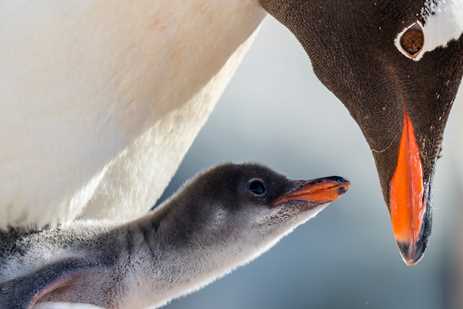Tourism to Antarctica is almost exclusively ship-based, and more cruise companies than ever before are offering Antarctic itineraries. Despite Antarctica’s remoteness and inherent wildness, it is unequivocally possible to voyage there safely, and to have an extraordinary experience—intimate, personal, exhilarating, life-changing. Ahead are the six most important questions to ask before you decide with whom to book your Antarctic adventure.
Get Inspired by Photos, Videos, Webinars, Stories, and Exclusive Offers.
Sign Up
What Kind of Ship is Best?
The style of vessel you choose for your Antarctic adventure will define your expedition experience. There are a variety of vessels currently voyaging to Antarctica: large and smaller cruise ships, icebreakers, polar adventure ships, and fully equipped expedition ships. For maximum safety, and to have a more in-depth experience, choose a polar-class vessel with a high ice rating in combination with a veteran ice team noted for superior navigational skills—both essential for safe and rewarding travel.
What Safety Features are Vital?
In addition to the inherent ice-worthiness and logistical operation of the ship, there are three important components to safety in Antarctica: Captain, staff and crew experience; onboard technology; and lifesaving protocol and equipment. A recent review of the available literature quoted some operators enthusiastically entering Antarctic tourism touting an “onboard physician” as a primary safety feature. While having a doctor aboard is undoubtedly important, there is far more to ensuring guest safety in Antarctica. The next two paragraphs highlight some of the baseline criteria to use in evaluating your travel provider.
Captain and Crew Experience
Captains who have attained the necessary experience navigating polar waters are called Icemasters. An Icemaster is not only familiar with the unique wind, weather, and current dynamics in polar waters, he or she is also intimately familiar with all the forms of ice and the unique challenges each form presents.
Onboard Technology
All passenger ships plying Antarctic waters are equipped with a GMDSS (Global Maritime & Distress Safety System) emergency communication system and a satellite weather forecasting system. However, more technology is available that can be harnessed for greater travel safety. For example, ice radar, ice searchlights, IAATO Emergency Response System, and a drone for ice navigation. Knowing that the ship you’re traveling on contains the latest in predictive, navigational, and safety technology further assures your peace of mind and your well-being.
What is the Travel Operator's Experience?
Now, more and more cruise lines have begun to add Antarctica to their itineraries. And many tour operators, accustomed to voyaging in “tamer” waters are leasing, or even building, adventure ships to offer Antarctic voyages, too. Given the number of reported ship mishaps in Antarctic waters, it is not hard to conclude many travelers and operators alike may be undertaking this too lightly. Make your selection based on ownership as well as expertise: control matters. And experience equals safety.
How Active Will Your Antarctica Experience be?
Antarctica is a place of extraordinary natural beauty. Someone traveling there on a 2,500-guest ship can enjoy a glimpse of the same scenery as guests aboard nimble expedition ships, but most else would be lost. Because Antarctica is not mere scenery, it is a place to be experienced, an ecosystem that delights upon closer inspection. It seems obvious that the experiences of a guest on an agile 126-guest or 148-guest ship, with the outdoors instantly accessible, and a guest on a huge cruise ship requiring elevators to reach viewing decks would be too different to compare. However, there are equally significant differences between traveling with a dedicated expedition company and other small ship operators. Investigate how engaged you will be able to be, what you’ll be able to do, and how often.
One could have a perfectly wonderful time in Antarctica seated in a deck chair with a pair of good binoculars. But genuine encounters with beauty, wildness, and the seldom-seen are the difference between wonderful and extraordinary. When choosing your operator consider if they have the tools to enable exhilarating up-close and personal experiences. For instance, Zodiacs; kayaks; cross-country skis & snowshoes; a dedicated undersea program; ROVs (Remotely Operated Vehicles); hydrophones.
Does the Travel Operator Offer Top Staff and Onboard Experts?
Most travel companies operating in Antarctica claim to have knowledgeable experts on board. It can be hard, therefore, to determine how to assure yourself of the most authentic, engaging, and informative experience. One metric may be to consider how the staff backgrounds match up with your personal interests. A generous ratio of staff to guests is another empirical gauge to use in judging an operator. A small number of guides can mean both fixed assignment to a group, and/or larger groups.
What is Their Commitment to Conservation?
Antarctica is an incredibly unique environment that needs to be approached with utmost awareness and responsibility. Look for a company with a strong track record of sustainability and responsible travel. A company that adheres to best practices should: implement environmentally friendly operations at all levels of business; supporting the conservation of nature as well as the cultures and communities where they travel; continually seek ways to innovate, protect and educate; and work to create lasting positive changes for our planet.
Experience, expertise, technology, and technique—the point of it all is this: To enable you to have the unparalleled thrill of heading into the unknown, armed with confidence in your leadership, to inhabit the vastness, and discover the wonder of being somewhere utterly new. We hope our guide will help nurture your dream of discovering Antarctica—one of the most exhilarating adventures the planet offers.
Main image: Gentoo Penguins in front of the ship National Geographic Resolution in Peterman Island, Antarctica, Ralph Lee Hopkins







